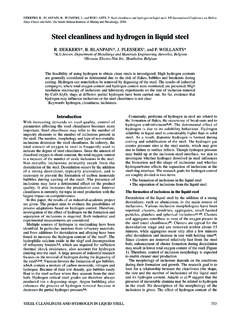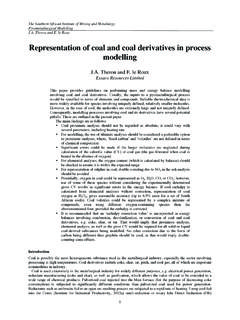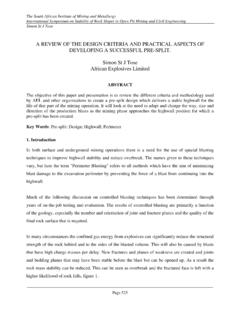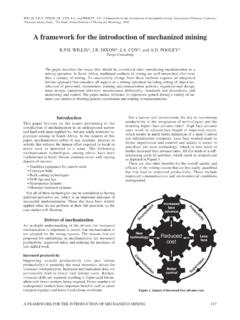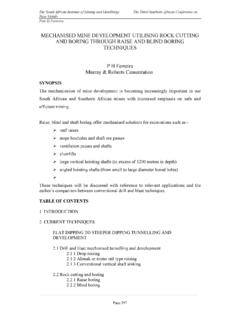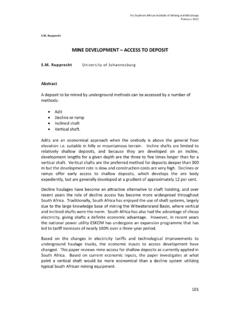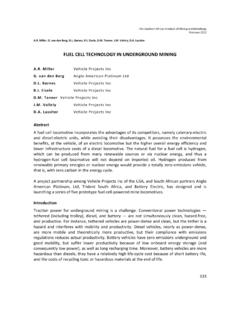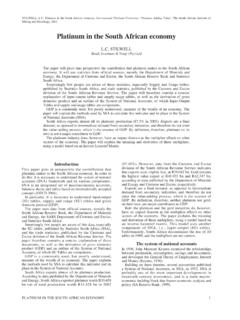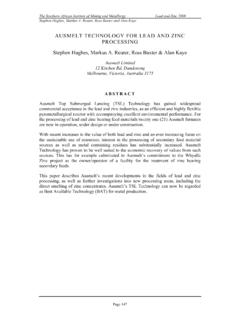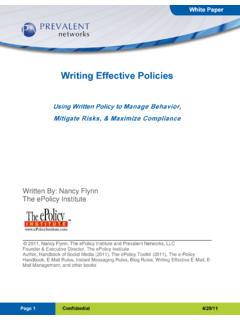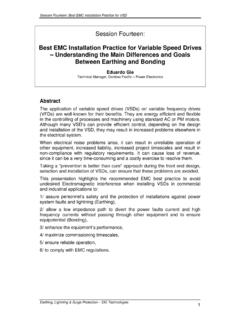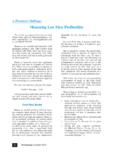Transcription of How applicable is industrial engineering in …
1 HOW applicable IS industrial engineering IN MINING?205 IntroductionMinerals are sold into a commodity market over whichminers have little control. As mining methods mature andstabilize, efficient and effective operations will define amine s competitive edge. Mines are realizing that in orderto achieve this they need to focus on a myriad differentaspects of their operations, from technology and the physicsbehind rock breaking, to the way in which people aremanaged. One of the aspects that is receiving increasedattention is understanding the value chain: how theelements of mining join together to deliver value. It is thesevalue chains that are at the heart of the discipline ofindustrial engineering . The discipline of industrial engineering is difficult todiscretely define or contain. The production and businessprocesses with which industrial engineering concerns itselfare intangible, and often exist without having beenexplicitly designed in the way a mechanical engineer wouldneed to design a piece of machinery.
2 In addition, theseprocesses transcend functions and hierarchies within abusiness, so that industrial engineering does not necessarilyhave a clear homebase within a , in spite of these vagaries and challenges, it isthe authors belief that in order for mining companies tobecome truly competitive, industrial engineering as adiscipline should be as integral to mine operation asengineering, mining or engineering as a disciplineIndustrial engineering is the integration of resources andprocesses into cohesive strategies, structures and systemsfor the effective and efficient production of quality goodsand services1. It is involved with the analysis, design,planning, operation and management of processes withinany environment from manufacturing and productionprocesses through to service processes and engineeringdesign processes. Good industrial engineering embraces asystems approach which encompasses all aspects of theorganization both horizontally across the value chain aswell as considering the key features which make up anorganization such as people, organizational structure,technology, information, measurement systems and theirimpact on business performance.
3 This is done through theuse of fundamental principles and specialized tools work practices reduce variability in outputand allow the different activities and sections in anorganization to interface more smoothly. Standardization isthe foundation that enables organizations to change andimprove their processes. In an environment where themethods and plans used to perform work constantly changefrom one worker to another, or one day or shift to another,high levels of variation are a certainty. This variation firstlymakes it impossible to plan adequately and secondly makesit very difficult to identify the root causes of problems. Inaddition, if any attempt is made to improve a poor workmethod, it will be difficult to implement changes and linkthem to improved outputs. Once flexible standards are inplace, effective problem solving can be implemented. Structured problem solving employs the scientific methodin approaching process design and are formed, and then tested through disciplinedexperimentation and rigorous analysis of facts and Deming PDCA (plan-do-check-act) Cycle is used toensure that this process not only prevents current problemsbut also encourages continuous improvement.
4 The planphase involves planning what is to be done regarding aproblem or challenge. This can be an extensive process thatinvolves collection of data and facts and stringent rootcause analysis followed by the development ofcountermeasures to address the issues that were found. Doinvolves taking action based on the findings from the planHATTINGH, and KEYS, How applicable is industrial engineering in mining? The 4th International Platinum Conference, Platinum in transition Boom or Bust ,The Southern African Institute of Mining and Metallurgy, applicable is industrial engineering in mining? HATTINGH and KEYSC entre for Mechanised Mining Systems, University of the WitwatersrandIndustrial engineering is being looked upon in more and more industries as a discipline that can beused to improve the overall effectiveness of businesses. It is a holistic discipline that draws uponmany philosophies, principles, methodologies and tools to optimize systems and processes tomaximize the use of all resources, so as to provide a product of increasing value to the said this, it is not a discipline that has traditionally been applied in mining and mining isarguably very different from traditional manufacturing sectors where industrial engineering has itsroots.
5 Two questions thus arise; how applicable is industrial engineering in mining, and how canindustrial engineering principles be implemented successfully? This paper discusses some of thefoundations of industrial engineering and how these are typically applied in practice. Criticalsuccess factors for implementation are also discussed. Case studies are then presented to illustratewhere industrial engineering has been applied successfully in mining. These case studies highlightthe approach used and critical success factors for implementing industrial engineering in asustainable IN TRANSITION BOOM OR BUST 206stage, possibly on a small scale, or in a pilot scenario. Thisensures that the action taken is addressing expected rootcauses. The check phase is critical as this ensures thatwhatever action was taken in do actually delivers thedesired results. Action is then taken based on these findingsto reinforce and sustain changes that were put in place toprevent recurrence of issues and share knowledge or to takedifferent action if the desired results were not engineers are also often involved in processoptimization projects that map processes out for a specificarea and then use tools to identify value adding activitiesand waste.
6 Techniques are then used to minimize waste andensure that value is delivered consistently and to the complex nature of many organizations, theseprojects often involve the use of advanced techniquesincluding computer simulation and other operationsresearch industrial engineering sees the business as a is applied to any process within the business that is seenas adding value to the whole. This includes the productioncycle and maintenance activities but extends to all auxiliaryfunctions that would include office-based processes such asprocurement. Due to the fact that processes often involve a variety ofstakeholders it is also common for the analysis and designof processes to extend outside of the primary organization sresponsibilities to those of other organizations that engineering has always, by definition, sought toimprove the productivity and efficiency of a firm. However,over time, different approaches have emphasized differenttools, techniques and philosophies.
7 industrial engineeringarguably has its roots in Tayloristic scientific management,where technical experts analyse production methods anddetermine the one best way of doing something. Thediscipline of production management that emerged in themid 20th century took a broader systems view, consideringthe interaction of different functions within an organizationand other disciplines, such as management science. Morerecently, improvement philosophies such as Theory ofConstraints (TOC) and Six Sigma have come to the fore,along with the management philosophies and toolsespoused in the Toyota Production System (TPS), and Lean Management. (A glossary and bibliography isincluded at the end of the paper.)Although industrial engineering has always advocatedunderstanding processes by spending time on the shop-floor observing and interviewing operators, it is not untilmore recently, specifically with the focus on TPS, that moreserious engagement of the workforce in the actualimprovement process has been introduced.
8 In TPS,continuous improvement advocates that, Any improvementmust be made in accordance with the scientific method,under the guidance of a teacher, at the lowest possible levelin the organisation. 2 This is at the heart of TPS and manybelieve that this is the key to implementing improvementsustainably in any many organizations have embarked oncontinuous or business improvement journeys in recentyears, it is often the case that initial quick wins are notsustained and that further improvement becomes more andmore difficult. Many firms successfully utilize tools fromLean, Six Sigma, or any number of other managementphilosophies to make easy productivity gains, but fail toshow sustained and continuous improvement. Recentresearch has thus focused specifically on how to implementthe theories in a sustainable has been suggested by Ball et. manyapplications of tools and techniques fail to take into accountthe conceptual frames which underlie the philosophies andin so doing, miss the point of applying the tools.
9 Theysuggest four frames that need to form the base off which allbusiness improvement initiatives are developed. Theseinclude: Understanding the purpose and linking initiatives tooverall business performance Developing a culture of problem awareness and seizingopportunities for improvement Applying a rigorous and disciplined problem solvingmethodology at all levels Developing the skills and mindset in people that allowthem to be effective problem essence the change in thinking has come about byacknowledging that there is a wealth of knowledge at alllevels in an organization and that continuously fightingfires and making short-term plans to achieve production isnot sustainable nor does it deliver continued improvementsin the expertise and knowledge that resides in arock-drill operator with twenty years of experience, or anexperienced technician. This knowledge has the potential tosolve problems and drive improvement, but only if giventhe opportunity and skills.
10 The function of management is not one of controlling andimplementation of the one best way , or managingnumbers and metrics, but rather one of mentoring andfacilitating discovery. Improvement is effected throughinvolving inquiry at every stage: How do you do this work?Do you do it the same way every time (standardization)?Why do you do this? Why is it important (purpose)? Howdo you know if it has defects (quality)? What causes thesedefects (problem awareness)? Why does this happen? Howmight this be solved? How can the results be measured(scientific method)? industrial engineering in practiceFor those who have implemented initiatives over the years,it is largely undisputed that the techniques of industrialengineering are able to make a significant contribution tooperating profitability. What is not so clear, however, iswhether these benefits are sustained and ultimately furtherimproved upon in the long engineering is often applied as an may be approached by bringing in a team of specializedconsultants either to address specific issues or to analysethe organization as a whole.
